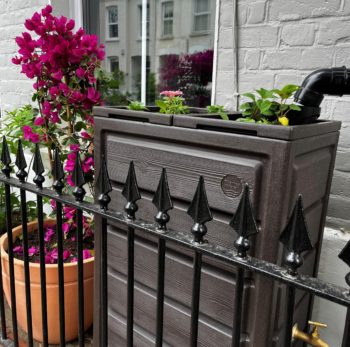Towards incentivisation for community-centric rainwater management
Competition: Breakthrough 2: Catalyst
Amount awarded: £225,000
Led by: Thames Water
Partners: Indepen Limited, Our Rainwater Limited, Isle Utilities Limited, South West Water, Anglian Water, Wessex Water
Project completed: February 2024
Water cycle tag: Customers and communities
Project Goal: To develop and test a model and digital platform for scaling up community-centric rainwater management (CCRM) to reduce pressure on water infrastructure and promote sustainable water practices in residential communities.
Key Objectives:
The primary objective of the project was to explore community-centric approaches to rainwater management by investigating incentives that could encourage residents to adopt rainwater capture tools. The project aimed to test the effectiveness of a community-based engagement approach, assessing motivations and barriers that influence participation in stormwater management initiatives. A crucial aspect of the project was the development of a blueprint that could be scaled and replicated across different communities. This involved defining metrics to quantify the value of disconnecting roof areas from sewer systems and understanding which incentives would be most effective in driving adoption.
In addition to engagement strategies, the project also sought to test different methods for encouraging community participation, including door-to-door engagement, digital campaigns, and community events. Another key focus was to assess the technical and logistical feasibility of installing water butts/planters, evaluating their installation challenges, maintenance requirements, and long-term performance.
Alignment with Ofwat’s strategic innovation themes:
- Responding and Adapting to Climate Change: By promoting rainwater harvesting and sustainable drainage solutions (SuDS), the project helps reduce the impact of climate change, such as flooding and water scarcity.
- Protecting and Enhancing the Environment: The project reduces pollution by decreasing combined sewer overflows (CSOs). It also promotes water conservation and natural drainage solutions.
- Delivering Long-term Operational Resilience: The project’s decentralized approach to rainwater management reduces the strain on existing infrastructure, improving long-term resilience.
- Testing New Ways of Conducting Core Activities: The project uses customer engagement, digital tools, and incentives to promote water conservation and community involvement in water management.
The project also aligns with broader water sector priorities, such as improving customer value, environmental performance, and collaboration.
Project Outcomes:
The project successfully engaged three communities in Waltham Forest, Lambeth, and Cirencester, where varying levels of participation were recorded. In Waltham Forest, 61 residents signed up for the scheme, leading to 27 successful installations. Lambeth saw 56 sign-ups and 34 installations, while Cirencester had 50 sign-ups resulting in 16 installations. These figures demonstrated both the potential and the challenges to implement rainwater capture at scale, highlighting how different community contexts influenced engagement and adoption rates.
Through this work, the project established a structured engagement model based on a wave approach, starting with early adopters, followed by empathisers, and ultimately targeting the wider majority. The findings contributed to a comprehensive blueprint outlining the engagement process, onboarding strategies, installation requirements, and monitoring frameworks. A digital platform played a key role in streamlining the process, allowing residents to sign up easily while facilitating efficient installation scheduling and communication.
From a technical standpoint, the hydraulic monitoring of installed planters confirmed that they successfully attenuated stormwater without experiencing blockages during the monitoring period. However, the project also uncovered logistical challenges, such as difficulties in installing planters in terraced houses due to shared downpipes and limited space. Delays between resident sign-ups and actual installations were identified as a key factor in reduced participation, indicating the need for a more seamless transition between engagement and implementation. Additionally, the importance of clear communication became evident, particularly in differentiating between terms like “water butt” and “rainwater planter,” to ensure residents fully understood the function and benefits of the installations.
Key Findings:
One of the most significant findings from the project was that strong community involvement is essential for the successful adoption of rainwater harvesting solutions. Working closely with local champions and existing community groups proved to be highly effective in increasing participation, as people were more inclined to install rain planters when they saw their neighbours doing the same. The project demonstrated that social norms play a critical role in influencing behaviour, reinforcing the idea that engagement should be approached at the community level rather than targeting individuals in isolation.
Digital engagement emerged as a more efficient and scalable method for reaching potential participants compared to traditional door-to-door outreach. The digital sign-up process not only saved time but also allowed for better data management and communication with residents. Additionally, the project highlighted that personal incentives were a key motivator for participation. While financial incentives were not the primary driver, residents valued the opportunity to take action against flooding in their local area. Offering free rainwater planters and installation was found to be a highly effective way to encourage adoption.
From a technical perspective, the project reinforced the need for thorough property assessments before installations, as different housing types presented unique challenges. Installation logistics, such as parking constraints and the need for permissions in shared or rented properties, were identified as factors that could hinder widespread adoption.
The delays in finalizing project collaboration agreements also had an impact, shortening the monitoring period from the intended 12 months to just 5 months. Despite these setbacks, the monitoring conducted within this timeframe provided valuable insights into the performance of the planters and confirmed their effectiveness in reducing stormwater runoff.
The project also revealed important considerations for scalability. While engagement strategies worked well with early adopters, achieving broader adoption across entire communities would likely require additional incentives and support mechanisms. The findings suggested that integrating these initiatives into local policies, potentially through partnerships with local authorities, could help normalize rainwater harvesting and encourage widespread participation.
Impact and Next Steps:
The project has demonstrated the potential of CCRM to contribute to a more sustainable and resilient water sector. Our Rainwater digital platform approach is now available for adoption to all water companies and other organisations interested in managing water. The findings and recommendations are in time for AMP8 and to inform future policy and investment decisions related to water management.
Based on the outcomes of the project, the next phase should involve expanding the initiative to additional areas, including communities that have not experienced flooding. This would provide valuable insights into how engagement strategies might need to be adapted for different demographics and levels of risk awareness. Further research is needed to assess how different community groups respond to rainwater harvesting initiatives and what additional incentives might be required to encourage widespread adoption.
A key priority for future work is extending the monitoring period beyond the initial 5 months to evaluate the long-term performance and maintenance of the installed planters. Understanding how community participation evolves over time will be essential in determining the sustainability of these initiatives. Further refinements in engagement and incentive strategies will also be necessary, particularly in identifying the most effective approaches for reaching the majority cohort who may not be as immediately motivated as early adopters.
To facilitate a broader rollout, the project’s blueprint should be applied to a wider range of geographic locations, testing its adaptability in different settings. Strengthening partnerships with local authorities and integrating rainwater harvesting into policy frameworks could help drive systemic change, making these solutions a standard part of urban water management strategies. By building on the findings from this initial phase, the project has laid the groundwork for a more comprehensive and impactful approach to community-based rainwater management.
Summary:
The CCRM project successfully demonstrated a novel approach to rainwater management, engaging customers and communities to promote the adoption of rainwater harvesting and SuDS. Key project outcomes included the development of a digital engagement platform, successful pilot programs, and valuable insights for future implementation. The project’s emphasis on community engagement, property-specific solutions, and quantifiable benefits contributed to its success. The CCRM project’s positive impact on the water sector includes cleaner waterways, community resilience, and potential cost savings for customers, demonstrating its potential for transformative change.




